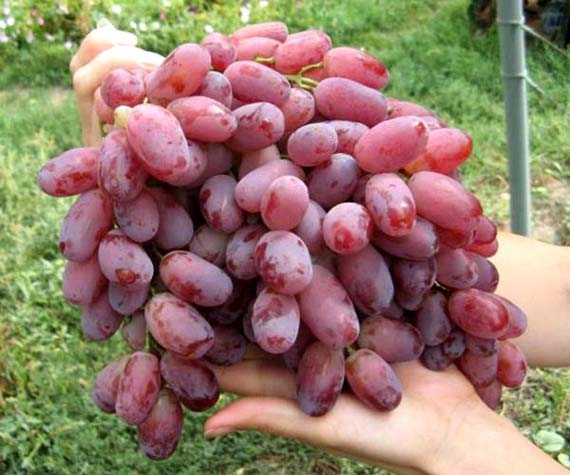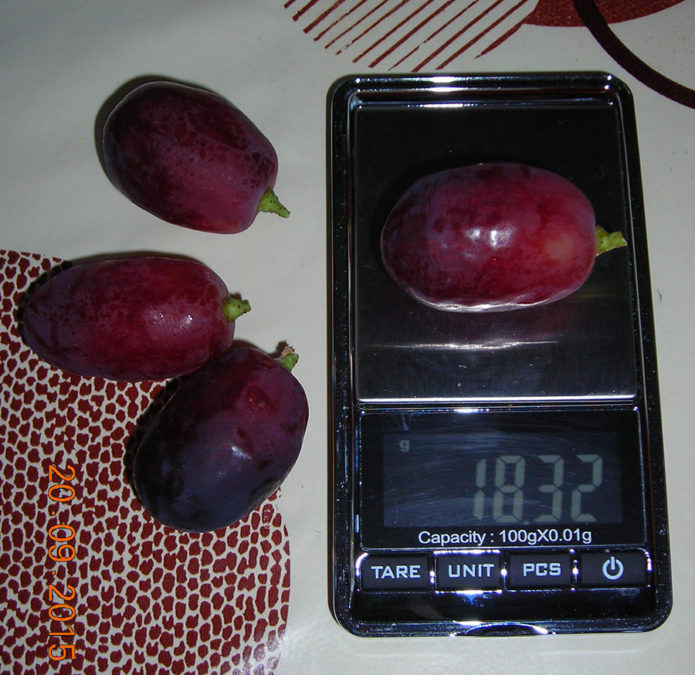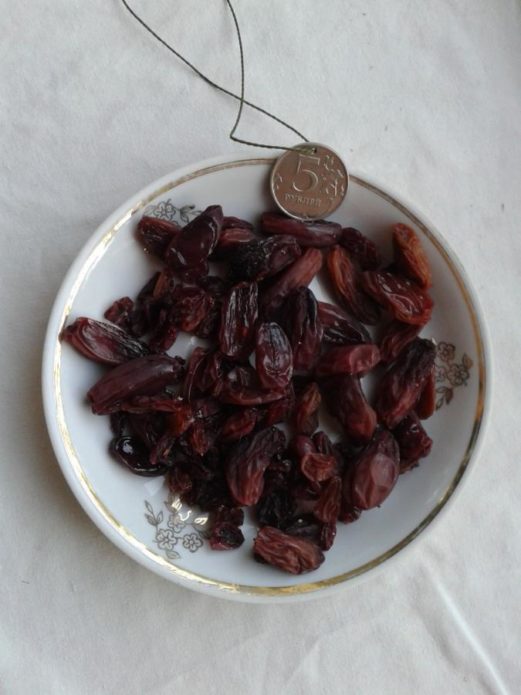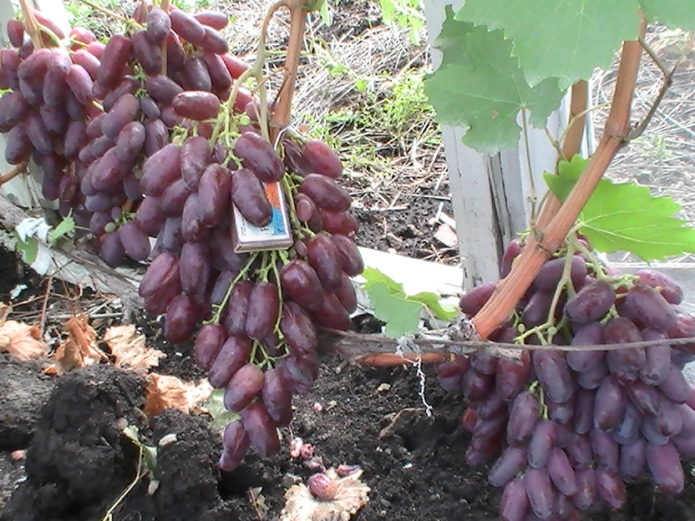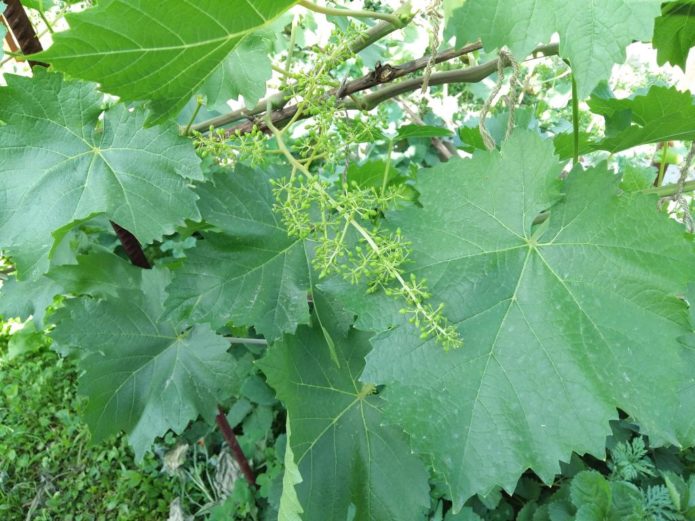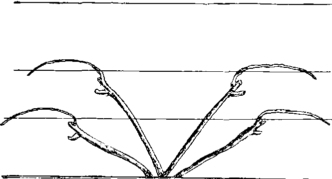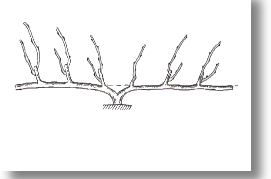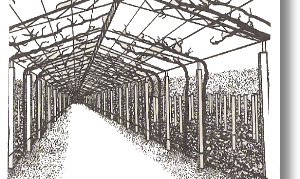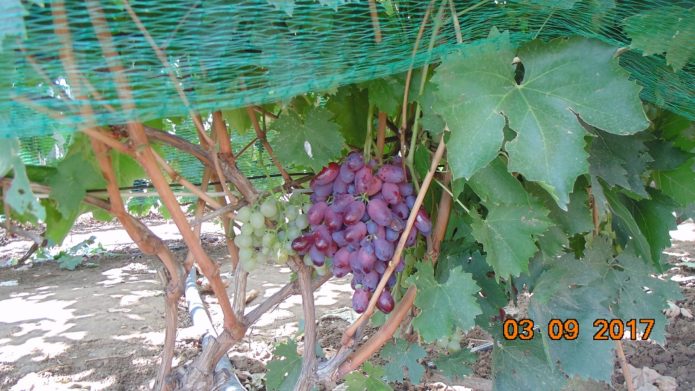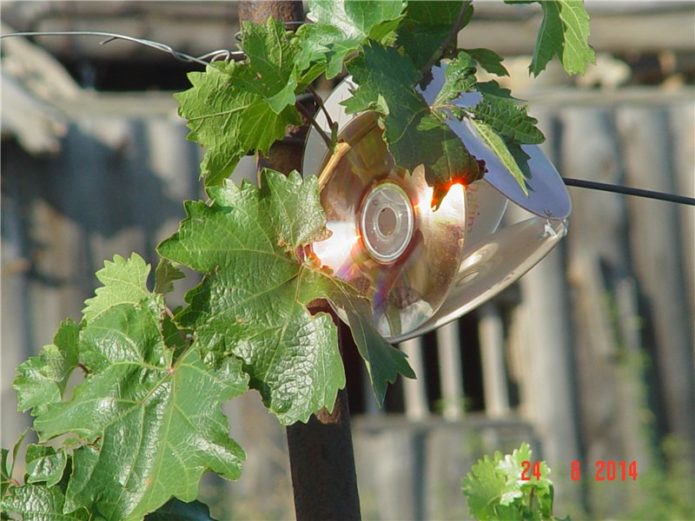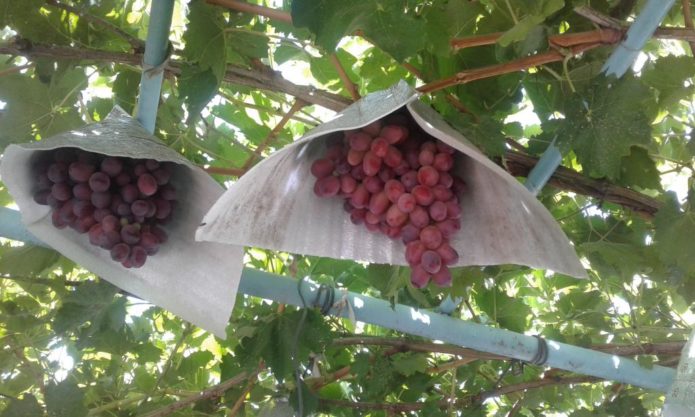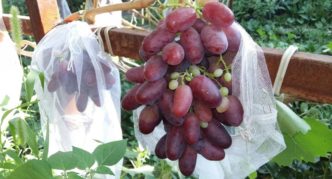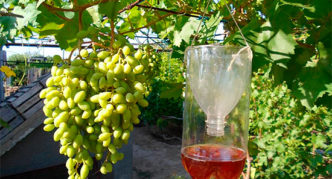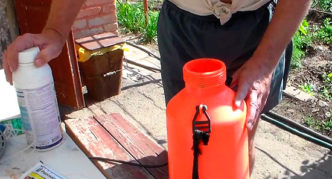Thanks to the achievements of breeders, gardeners have the opportunity from a huge number of resistant varieties and hybrids of grapes to choose exactly the one that suits the climatic conditions and will suit their taste. New grape forms are pushing into the background the varieties that were bred earlier, which are less resistant to disease and frost. Many people consider Rizamat grapes to be such a forgotten exhibit, calling it “yesterday's day of viticulture”. But is it worth neglecting the classics? Let's try to figure it out in this article.
Content
Description and characteristics of the grape variety Rizamat
The Rizamat grape variety was bred by a group of authors at the Samarkand NPO SViV named after R.R. Schroeder. The parental pair are grape varieties Katta-Kurgan and Parkent.
Rizamat is a liana-like, very vigorous shrub, distinguished by its special strength and growth rate. Hrones and fruits have an attractive presentation. Tasting taste score is high - 9.1 points.
The appearance of the grapes has a number of distinctive features, presented in the table.
Table: external signs of Rizamat grapes
| Leaves | medium-sized, rounded, five-lobed, slightly dissected, glabrous below |
| Bunches | large, conical, branched, medium density. The mass of the bunch is 800-2500 g. |
| Berries | very large, cylindrical in shape, pink, with one more intensely colored barrel, covered with a wax coating of medium density. |
| Taste characteristics: | sugar content of berries - 18–21 g / 100 ml. Acidity - 5-6 g / l. |
Rizamat grapes have the following characteristics:
- It is considered a table-raisin variety. The fruits can be eaten fresh, are suitable for cooking compotes and preserves, as a result of their drying, high-sugar large black raisins are obtained.
- The skin of the berries is thin, almost imperceptible when eaten. The taste is harmonious.
- Refers to varieties of medium early ripening - 140-150 days. The crop can be harvested already at the end of August - mid-September (depending on the weather).
- Productivity reaches - 20-25 t / ha. Bunches should be cut as they ripen. When hanging on a bush, it loses its taste.
- The flowering of this variety is bisexual, so there is no need to plant pollinating varieties nearby. Pollination is good, no artificial pollination is required.
- Disease-resistant.
- Has a weak frost resistance - from -15 to -180C. Requires a reliable shelter for the winter.
- For early and complete ripening of fruits, it requires a lot of heat (the optimal sum of active temperatures is 2800-3000 ° C).
The Rizamat grape got its name in honor of the famous Uzbek winegrower Rizamat Musamukhamedov.
Video: Rizamat grape variety
Video: characteristics of Rizamat grapes
Features of planting a bush
Rizamat grapes are best propagated by planting seedlings. It is carried out in a standard way, however, when choosing a place for landing, some nuances should be taken into account:
- the vine requires an increased feeding area, so it is difficult for it to tolerate the close proximity of other bushes (it is recommended to observe a minimum distance between them of 2.5–3 m);
- for the full ripening of fruits and vines, the bush needs a large amount of heat;
- drafts and wind have a detrimental effect on grapes;
- the bush does not tolerate stagnant water.
This means that the ideal landing site is the southern, sunny side of the site, sheltered from the wind with deep groundwater. The minimum distance from buildings and fences is 1 m. A single planting of a landing pit prepared in advance (not earlier than 2 weeks) is considered optimal.
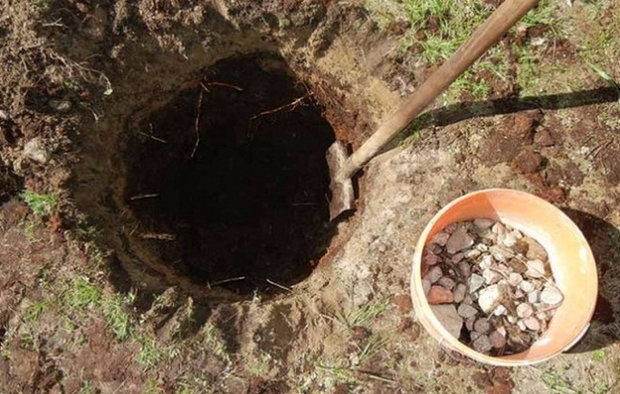
The planting pit is prepared, as a rule, in the fall: a pit is dug, drainage is organized, organic fertilizers are applied
Recommended pit sizes depend on soil characteristics:
- for black soil - 60x60x60 cm;
- for loam - 80x80x80 cm;
- for sand 100x100x100 cm.
After planting, the seedling is mulched, tied to a support and watered with warm water.
Secrets of caring for Rizamat grapes
Rizamat grapes are considered quite capricious and demanding in terms of care. If the rules of agricultural technology are not followed, peas appear, pollination depends on the weather, fluctuations in humidity cause cracking, etc. What conditions must be created for the Rizamat grapes so that they feel comfortable, we will consider below.
Watering
For Rizamat grapes, proper watering is one of the most important values. First, in the absence of watering, the berries become smaller, signs of peas appear. Secondly, irrigation should be regular, since with sharp jumps in the level of moisture in the soil, the berries crack strongly.
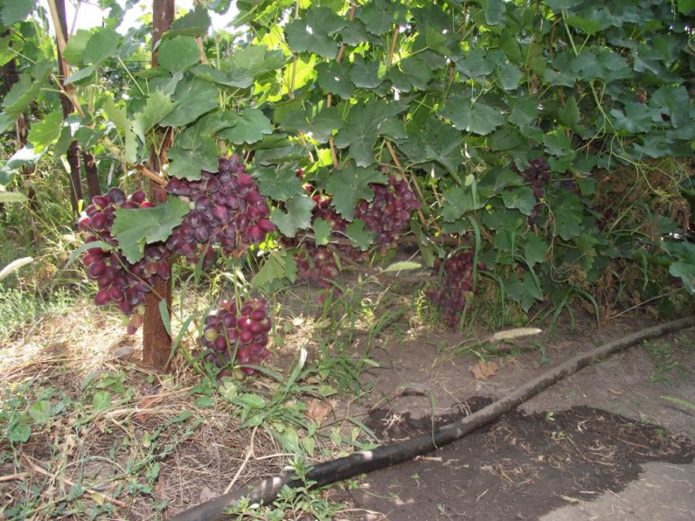
Drip irrigation allows you to maintain a constant level of humidity under the bush, without sudden changes
The frequency of watering depends on the type of soil on the site and the climatic conditions of the region. There is a debate about this issue among fans of Rizamata. Some argue that 1-2 abundant irrigation per month is enough for the bush. Others (and they are in the majority) that the soil under Rizamat must be kept constantly moist, that is, watering every 3-5 days, and during the period of berry coloring (August) it is recommended to reduce watering to once a week.
Rizamat prefers drainage irrigation, categorically does not like furrow irrigation. In the second case, there is frequent mildew infection.
Hello. After the break with the harvest five years ago, when not only the rizamat, but also the cardinal went to feed the flies, he began to water it every 3-5 days. Result: 1-2 percent of the berries cracked. From the next year, I began to water it every 2-3 days. Result: last year, the year before last, not a single berry cracked. I didn't measure water in liters, in a ditch. For 40 years I grew up on the sand, but here I got caught on the clay, the soil must be taken into account.
Bush shaping
When choosing the type of trellis and the method of forming a bush of the Rizamat variety, several features must be taken into account:
- vigorous bush - takes up a lot of space;
- this variety does not produce inflorescences at the beginning of the arrow, therefore, likes long formations;
- for normal fruiting, the plant requires a large supply of perennial wood;
- the bush requires shelter for the winter.
Therefore, fan, cordon and arched forms of formation are suitable for Rizamat. The choice of a specific system depends on the climatic growing conditions and the space allocated by the gardener for one bush.
Photo gallery: optimal methods of forming Rizamat grapes
- The advantages of fan-shaped molding include compactness, ease of formation, convenience in a winter shelter.
- The advantages of a two-armed horizontal cordon include a large amount of perennial wood, which makes it possible to grow a very powerful bush with huge fruit potential.
- Arched or arbor molding is considered the most powerful and productive, but laborious to maintain and form
Video: shaping grape cut in the first year
Pruning
Like most Central Asian varieties, Rizamat prefers long pruning with 12-14 eyes. This is due primarily to the fact that the first 5–6 eyes on the fruit arrow are sterile. However, most winegrowers prefer to cut into 16-18 eyes in the fall, and break out almost all barren ones in the spring. The load on an adult bush is about 60 eyes (and with an arched formation, 3-4 times more).
The minimum distance between the vines on the trellis for Rizamata is 50 cm, the rest is cut out. Typically, one bunch is left on each vine.
Green operations are also important for full-fledged fruiting: pinching and chasing. Stepchildren should be removed while they are still in a herbaceous state, leaving 1-2 leaves. In the absence of pinching, fruiting buds may underdevelop.
Minting must be done when the shoots outgrow the top of the trellis, leaving 12-15 leaves above the bunch. This procedure is carried out in late July - early August and promotes faster ripening of the crop and vines.
To give the berries a more intense color, it is recommended to remove 1-2 leaves near the bunches during the ripening period of the berries.
Fertilizer
Rizamat grapes, due to their fertility, need additional regular feeding. They are used as organic matter, wood ash and potassium phosphate fertilizers. Initially, it is better to introduce these substances when organizing a planting pit, and subsequently when watering.
Disease prevention
Since Rizamat grapes are not resistant to diseases, the plant should be regularly sprayed against diseases.
Prevent the appearance of fungal diseases by treating the bush with copper sulfate or Bordeaux liquid 4-6 times during the growing season, depending on the weather. Comprehensive disease prevention also involves measures for tying shoots, pinching and weed control (for better ventilation of the bush).
However, preventive measures do not always save you from infection. With the timely detection of the disease and the immediate use of modern fungicides, the crop can be saved with low losses.
The main symptoms of mildew damage to grapes is damage to all green parts of the vine: leaves, shoots, inflorescences, berries and tendrils. In particular:
- on young leaves of grapes, the disease causes characteristic pale green or yellow slightly transparent oily spots of various shapes and sizes;
- longitudinal depressed brown spots appear on green shoots, antennae and ridges;
- green inflorescences and berries turn brown and die off.
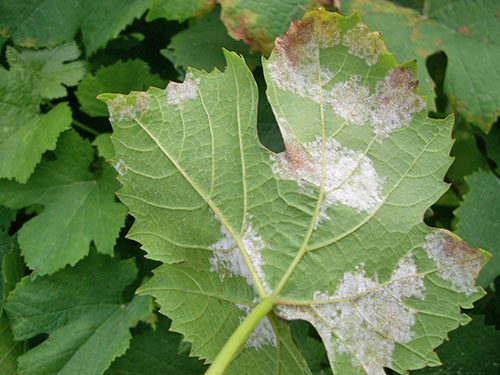
The first signs of mildew are found precisely on the leaves.The spread of the fungus is indicated by oily traces on their upper surface and an inconspicuous whitish coating on the back of the leaf plate.
You can save the plant and the crop from mildew by treating the bush (especially carefully the lower part of the leaves) with systemic copper-containing preparations (Ordan, Ridomil, Polykhom, Oksikh, Silk, etc.)
If you notice that the leaves have begun to curl, grayish spots have appeared on them, there is mold on the processes, and brown spots are spreading on the vine - these are signs of oidium. The plant can be cured with colloidal sulfur or with Bayleton, Topaz, Skor, etc.
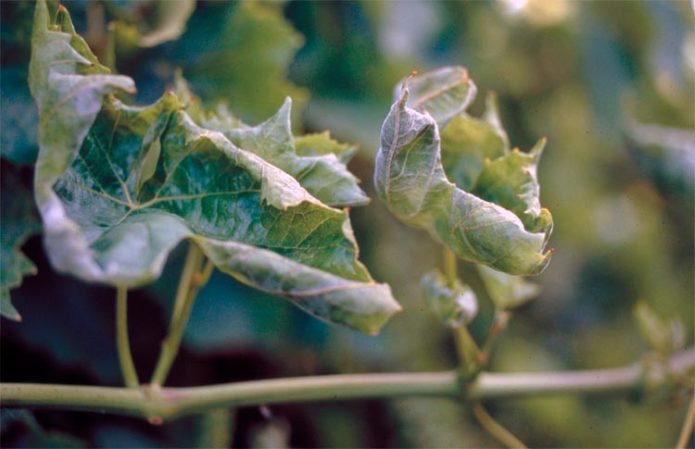
Without a comprehensive treatment, oidium is able to destroy not only the crop, but the entire grape bush.
Pest control
The sweet juicy berries of Rizamata are delicious not only for humans, but also for birds and wasps. These pests can destroy a significant part of the crop and spoil the presentation of the bunches. Therefore, the fight against them is an integral part of plant care.
There are several ways to protect grapes from birds:
- the use of nylon networks;
- the use of various rattles, scarecrows, sparkling objects;
- construction of umbrellas over each bunch.
Wasps are attracted by the aroma of fruit damaged by birds or subsequently cracking. Special protective bags, home-made traps or pesticides help to fight the invasion of these insects.
Photo gallery: ways to protect grapes from wasps
- Mesh bags worn on each bunch of grapes are the safest and most reliable way to protect against wasps
- You can fill such an artisan wasp trap with mash, beer with sugar or bread kvass, but a honey solution or sweet syrup can attract and destroy beneficial bees
- Bunches and bushes can be sprayed with deterrent chemicals, but when eaten, such grapes will have to be thoroughly washed
One of the folk remedies to protect grapes from wasps is to sprinkle it with wine or table vinegar. It is non-toxic, is easily washed off by rain and retains its deterrent effect for several days or weeks.
Shelter for the winter
Rizamat is a covering variety. Measures to protect the bush from frost give winegrowers a lot of trouble due to its strength of growth. At the end of autumn, as the vine matures, it is necessary:
- Remove the top of the vine from the trellis or arch.
- Carry out trimming.
- Snap to the bottom of the bush.
- Wrap with a thick cloth (for example, burlap), the second layer is polyethylene with holes for ventilation and again a thick cloth.
- In conditions of very frosty winters (over -20), it is necessary to sprinkle it with earth.
Such a shelter works like a thermos, providing a constant temperature regime and avoiding the twisting of the vine in the event of thaws.
Take your time to open the Rizamata bush in early spring, even when there is a temporary warming. Night frosts can deal significant damage to him. You can water the top layer of fabric with water, thus cooling the bush and suspend premature bud opening.
Advantages and disadvantages of the variety
So, having considered the main characteristics and features of growing Rizamat grapes, we can note its strengths and weaknesses in comparison with other early middle varieties and hybrid forms.
Table: advantages and disadvantages of the Rizamat grape variety
| Advantages of the variety | Weaknesses of the variety |
|
|
Video: Rizamat grape variety: strengths and weaknesses
Reviews
Good day. I would like to share information on how Rizamat behaves in the Volga steppes, that is, in a sharply continental climate ... The bush is already five years old, the growth of the vine is very powerful ... I will not say that Rizamat is a very capricious variety ... Well, stepchildren have to break off yes ... I have a minimum of chemical treatments, the same as for other varieties ... The only thing is that I have to tinker with shelter for the winter ... I cover it with earth, because otherwise the mice will gnaw the whole vine ... But these labor costs completely pay for themselves, since in terms of the beauty and size of the bunches, here, in my opinion, no sort was standing nearby ... When you put a bunch of "Rizamat" on the festive table, then everyone's lip hangs down to the ground ...
A variety with a capital Rizamat was, is and will remain, and it also remains a culture of a place that does not suit him. I live 100 km from Cherkassy, my bush grows from the north-western side of the house, in partial shade (approx. 30%) and even then, with standard protection, it ripens annually at the time of Arcadia. The only problem in my conditions is the crackling of berries during the ripening period, but gradually I eliminate this drawback, this year only single berries are cracked. Small peas occur every year, first peas I cut it out, then I stopped it - I use it as an indicator - the peas are colored - you can safely cut it off, especially since it does not spoil the appearance of the bunch at all, but rather is the hallmark of the variety.
Good afternoon! The photo shows the grape variety Rizamat. The bushes are vigorous, productive, the vine ripens well. The bunches are large, branched, of medium density. The berry is very large, the skin is thin, the flesh is dense, crispy. Respectfully.
Good day to all! My Rizamat (6th growing season) had its fifth fruiting this season. The summer was cool, the delay in all varieties was up to ten days. But it so happened that Rizamat managed to skip the most “noisy” period with minimal losses and in September to gain good sugar and taste. As a result, almost all of them went for food, being cut off at the beginning of October before the threat of severe frosts. And wasps this summer, one might say, was not - they love him. The vine matured to the top wire and quite early, the oidium did not have time to sit on it. I hope it will please you again next season. I continue to hold it (2 bushes), despite some problems with the crackling of berries.
in my opinion, rizamat is a classic that will outlive many new items. as for me one of the most delicious varieties. as for yourself it is worth tinkering ... so that on dozens of bushes of rizamata he will pull too much attention on himself .. and a couple of bushes is worth it !!! because of the taste! This year, for the first time in 6 years, I saw on it the rudiment of odium. In June, it rained good. I went through with a chorus and a week later Shavit + Topaz for 8 liters. The result is positive. and my airing is poor because of the tight fit.
So, despite the fact that Rizamat grapes require special growing conditions, all of its shortcomings are leveled by high yields, an amazing view of bunches and an excellent taste of berries. After all, it is not for nothing that among experienced winegrowers to this day there are a large number of connoisseurs of this variety, who are able to experiment and invest their labor and their soul in the cultivation of Rizamat vines.
